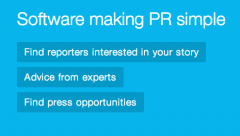Go go gadget….news release?
Imagine a brave new world of news release creation and distribution where companies ‘plug and play’ important tidbits into a mad libs-style template, and then shoot out releases to algorithm-generated reporters.
Scary, huh?
This was what I was expecting to find when I ventured over to PressFriendly, a new PR startup that hopes to serve as a ‘virtual PR firm.’
The platform, which targets startups, takes founders and internal company marketing representatives through a process of developing a pitch, creating a release, and reaching out to selected media.
Co-founder and CEO Joel Andren started the company after both working in a startup himself, and talking to more than 200 founders about their experiences with public relations firms.
As he says in a blog post introducing the platform:
Not a single one of them had a good experience with PR. “Overpriced” was the number one complaint we heard. “Difficult” was the number two complaint. Many of the founders who’d raised money had chosen to work with an agency and all of them told us they regretted it.
So, PressFriendly was started as a democratization of sorts. Bring the power of PR to the people (insert rallying fist pump)!
Setting Up PressFriendly
I set myself up a ‘company’ (PetroPower, Inc., of course). And went through the process of creating my release about our recent acquisition of 80 percent of the universe.
The system prompted me with great tips, best practices, questions, and other things to think about as I was going through the process. When I reached the end I was fairly impressed by the quality of prompts along the way. This was not the mad libs style monstrosity I had expected. In the right hands, it could be extremely useful in helping a startup put together an interesting story for a reporter.
In the right hands is the key here.
Why PressFriendly Can’t Replace an Integrated PR Firm
Without a doubt, savvy startup founders should know their company and industry best. As an outside firm coming in, our first job is always to dive deep into that knowledge, and integrate ourselves into the organization in a way that allows us to combine our communications and media relations skills with a seamless knowledge of the organization and landscape. In many ways that’s one of the most crucial parts of what we do.
As an outside observer coming in, we are also able to give a perspective as to where and what the story angles are. This is something very hard for an organization to do, especially one not equipped with trained and skilled communications professionals. Anyone who has ever worked in startup land knows you tend to live, breath, and sleep in the microcosm of your organization. This passion is often necessary to fuel the drive, determination, and hard work needed to launch a successful business, but it doesn’t come without it’s drawbacks.
A big one being perspective.
One of the most common situations we encounter with startup clients is having to explain to them that many of the facts they believe to be pitch worthy, are not only not front page Wall Street Journal news, but often not really news at all.
Our job is to go in and find the really interesting stories, the ones that are news. The ones that will position their company in the long term as a major player in their industry, as well as a trusted source for other media outlets. Our job is also to look beyond the pitches at the entire communications ecosystem, and put together a strategy to ensure all media channels (paid, earned, owned, shared) are reinforcing the same messages we are pushing forward in our conversations with reporters.
That’s a big difference than just writing and pitching a release.
How PressFriendly Can Help You
When I reached out to Joel and asked what he wanted to tell PR professionals who might be turned off by his platform, he said, “We’re not trying to replace the PR function, we’re automating the labor-intensive tasks of building media lists and creating editorial calendars to free up more time for strategic consulting.”
(PressFriendly provides ‘strategic consulting’ as a paid service in amounts ranging from a simple release review to 10 hours monthly).
He also emphasized they were very against “spray and pray” tactics, and have created a sophisticated algorithm to provide a list of 40-60 reporters for the purpose of encouraging users to build relationships with them over time.
Overall, PressFriendly seems like a great, cost savings alternative to bad PR – you know, the type all of us here have discussed often, and cringe when we see. But by doing so, it reinforces some of those same bad habits we hope to break.
There is no doubt the setup, tutorials, and support Joel and his team have created can be used successfully by startups looking to launch their media relations campaigns.
The more important question in my mind though, is less what’s gained in the short term and more what’s lost long-range?
